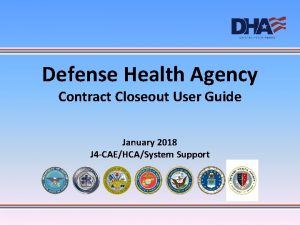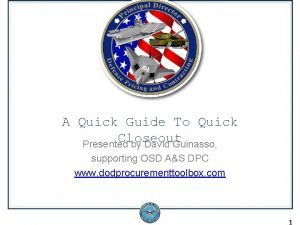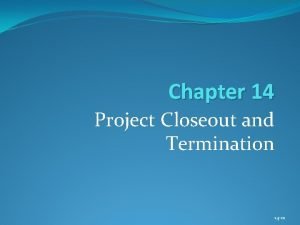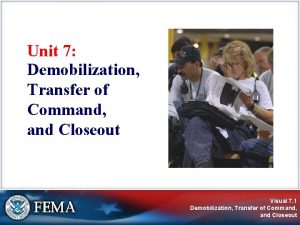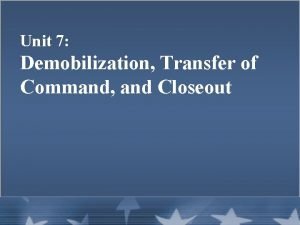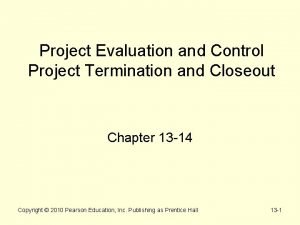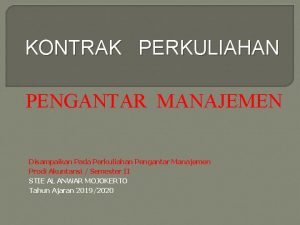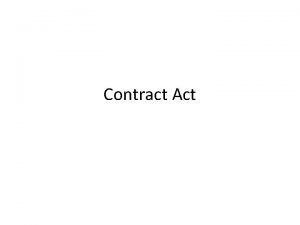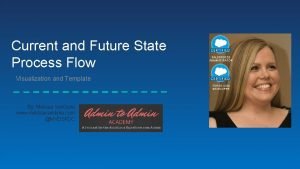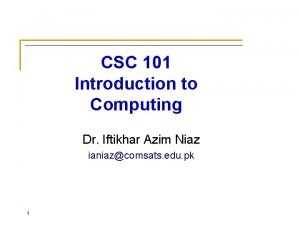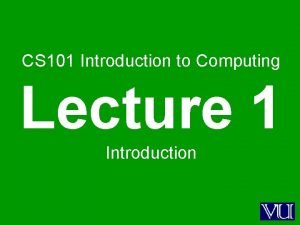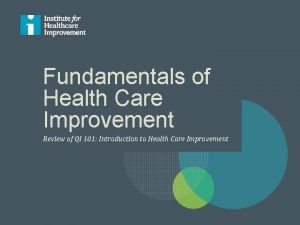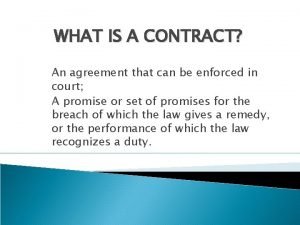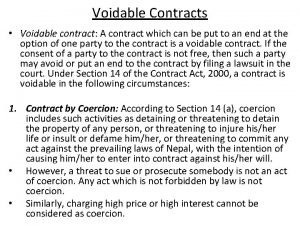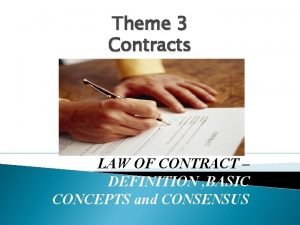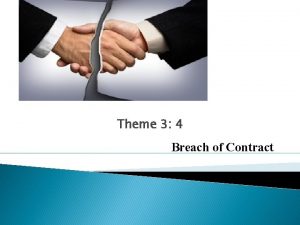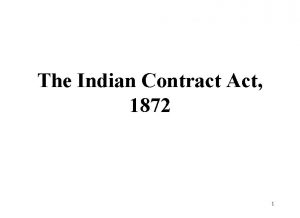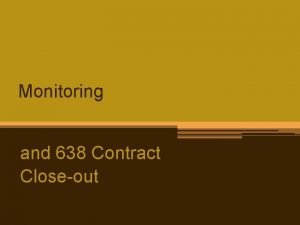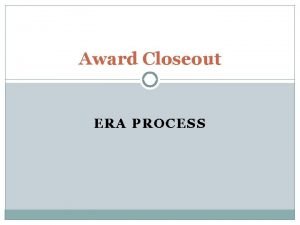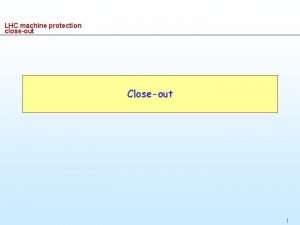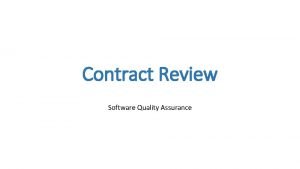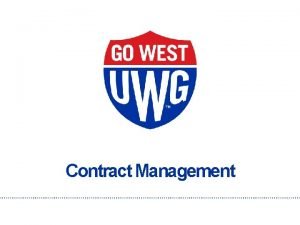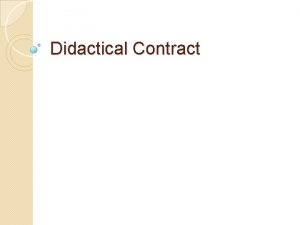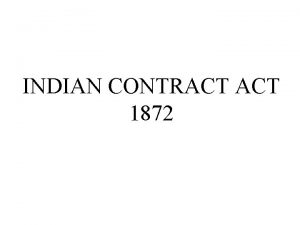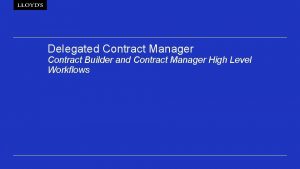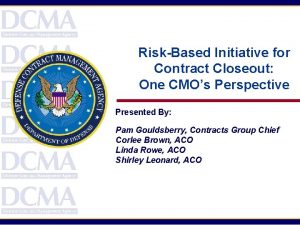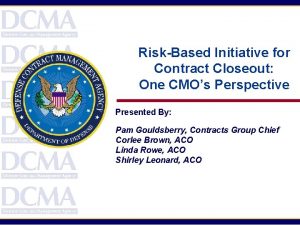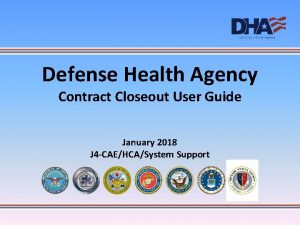Contract Closeout 101 An Introduction to the Closeout








































































- Slides: 72

Contract Closeout 101 – An Introduction to the Closeout Process Presented By: Reed Vander Schel Administrative Contracts Officer Grants/Cooperative Agreements Officer DCMA BOSTON Version 6– Apr 7, 2015

Introduction Contract Closeout – An Introduction to the Closeout Contract closeout is the final phase of the contract life cycle. • DCMA, the Administrative Contracting office, is responsible for performing administrative closeout of contracts after receiving evidence of physical completion • DCMA’s closeout process – Provides timely notice of physical completion to the Buying Activity; Requires early identification and return of excess funds to the Buying Activity; Generally avoids canceling funds situations; Provides timely final payment to Contractors; and Avoids spending excess administrative costs related to keeping physically complete contracts in an “open” status. 2

Objectives of this briefing are as follows - • Provide a basic understanding of the closeout process; • Become familiar with higher-level regulatory requirements for contract closeout; • Recognize functional specialists and other Agencies involved in the closeout process; • Provide an understanding of specific terms related to the closeout process; • Provide a high-level overview of initial closeout actions as well as actions related to specific types of contracts; and • Discuss the impact of not closing contracts within FARmandated time standards. 3

Authorities, Responsibilities and Closeout Terms 4

Authorities, Responsibilities and Closeout Terms • A review of higher-level regulatory requirements (FAR, DFARS, and DFARS PGI), Federal Acquisition Regulations (FAR), Defense Federal Acquisition Regulations Supplement (DFARS), Procurement Guidance Instruction (PGI) • Identification of who is involved in the closeout process and the associated responsibilities, and • A discussion of closeout terms commonly used. 5

Higher-Level Regulatory Authorities Contract closeout is delegated to DCMA in accordance with FAR 42. 302(a)(65) -- Accomplish administrative closeout procedures. Specific regulations regarding closeout of contract files may be found at -- • FAR 4. 804, Closeout of contract files; • DFARS 204. 804, Closeout of contract files; • DFARS PGI 204. 804, Closeout of contract files; and • DODI 5220. 22, National Industrial Security Program • FAR/DFARS Clauses for specific contract Close out Functional specialists base closeout actions on higher-level regulatory authority, DCMA Instruction and the terms and conditions of the individual contract. 6

Who Leads the Closeout Process? The PCO/ACO Leads the Closeout Process …. PCO/ACO …. And ensures coordination between: • • • DCMA Functional Specialists Defense Finance and Accounting Service Buying Activity Defense Contract Audit Agency Contractor Office of General Counsel (as necessary) Defense Industrial Security (as necessary) Inspector General (as necessary) Department of Justice (as necessary) 7

Contract Closeout Time Standards FAR 4. 804 sets specific time periods for closing contracts. The time period for closing a contract is based upon both the type of contract and the date of physical completion. 8

Time Standards - FAR 4. 804 Contract Type Calendar Months • Contracts using simplified Evidence of receipt of property acquisition procedures and final payment • Fixed Priced contracts 6 months after physical completion • Contracts requiring settlement of indirect cost rates 36 months after physical completion (COST-REIMBURSABLE CONTRACTS; DCMA includes hybrid, T&M and LH Contracts) • All other Contract types 20 months after physical completion (FIXED PRICE REDETERMINATION, FIXED PRICE W/ECONOMIC PRICE ADJUSTMENT, FIXED PRICE INCENTIVE, BASIC ORDERING AGREEMENTS INDEFINITE DELIVERY CONTRACTS BLANKET PURCHASE AGREEMENTS (BOA/IDCs/BPA) 9

Time Standards – Contract Type • The following shows FAR-mandated time standards in relation to MOCAS contract type codes -FAR-Mandated Time Standard (FAR 4. 804) Timeframes MOCAS Codes and Contract Types 3 Months J - Fixed Price Unilateral Purchase Orders 6 Months J - FIRM FIXED PRICE 36 Month R - COST-PLUS AWARD FEE S - COST CONTRACT T - COST SHARING U - COST-PLUS-FIXED-FEE V - COST PLUS INCENTIVE FEE Y - TIME AND MATERIALS Z - LABOR HOUR 20 Months A - FIXED PRICE REDETERMINATION K - FIXED PRICE W/ECONOMIC PRICE ADJUSTMENT L - FIXED PRICE INCENTIVE O - OTHER – BASIC ORDERING AGREEMENT/INDEFINITE DELIVERY CONTRACTS/BLANKET PURCHASE AGREEMENT (BOA/IDCs/BPA) Remember: The type of contract, dollar value and contract clauses impact the effort required to administer the contract, including the effort to perform closeout actions. A fixed price contract requires minimal closeout time and effort, while a cost reimbursable contract may take up to 3 years to settle all contractual issues. 10

Closeout Terms It is important to understand the definition of specific closeout terms commonly used. • Physically Complete* - A contract is considered physically complete when: Phy s Com ically plet e? • The Contractor has completed required deliveries and the Government has inspected and accepted the supplies, or the Contractor has performed all services, and the Government has accepted these services, and • All option provisions, if any, have expired, or • The Government has given the contractor a “Notice of Complete Contract Termination. ” • Overage – A contract is considered to be overage when it has not been closed within FAR-mandated time standards. • Closed – A contract is considered to be closed when all administrative actions, including final payment, has been completed and all disputes have been settled. • Closed On Time – A contract is considered to be closed on time when closeout is achieved within FAR-mandated time standards. *Notes: 1. Date of physical completion triggers the start of the FAR-mandated time standard. 2. Contracts administered in MOCAS the physical completion date is based on the date the contract moves to Section 2 (FAD - Final Acceptance Date). 3. For contracts not administered using the MOCAS System – contracts are considered to be physically complete when final acceptance occurs. 11

Overview of MOCAS 12

Overview of MOCAS It is important to understand how the MOCAS System is designed to facilitate contract closeout. The overview includes – • Storage of electronic contract information, • A review of the basic design of MOCAS, including Parts and Sections, • The contract life-cycle compared to MOCAS, • Automatic versus manual movement in MOCAS, • Using contractual information in MOCAS to manage contract workload, and • Electronic system access required to close contracts and available training. 13

Electronic Contract Information • Mechanization Of Contract Administration Services (MOCAS) is -- • An integrated contract administration and payment system. • Designed to provide DCMA and the Defense Financial Accounting Services (DFAS) with electronic information necessary to accomplish their mission of contract and payment administration. 14

MOCAS Internal Databases • MOCAS provides three separate databases to hold DCMA contract three information: • MOCG; MOCH; and MOCL • Contract Management Offices (CMOs) are assigned to a database and are identified in MOCAS by organization codes (e. g. , DCMA Manassas = Org Code WV) • MOCAS database general alignment by state MOCL Also includes all OCONUS CMOS MOCH MOCG Includes Americas Note: Some exceptions exist to the general alignment and are identified in the CAS Directory. However, t rule is “a CAGE code may only be administered by one CMO and a CMO is only assigned to one MOCAS D 15

MOCAS Parts and Sections • MOCAS assigns contracts to PARTS and SECTIONS. PARTS • MOCAS Part is assigned according to the degree of Part attention and management expected for the contract - • Part A Contracts: Contracts are expected to require extensive controls due to special requirements contained within the contract (e. g. , complex payment instructions, clauses, high level surveillance or inspection requirements, etc. ); • Part B Contracts: Contracts are expected to require few or no controls and are administered on a “management by exception” basis; and • Part C Contracts: Contracts have been received for support administration by one or more of the CMO functional elements, except for payment-only contracts which are assigned to Part C. Note: DCMA is responsible for closing Part A contracts. Part B contracts move to Section 5 (closed) when final payment has been made and DCMA takes action only when necessary to resolve administrative issues. Part C PAY-only contracts are closed/moved by DFAS Columbus. 16

MOCAS Parts and Sections • MOCAS Section assignment refers to the activity status of the contract Section • Section 1: Active contracts, i. e. , contracts on which delivery/acceptance, performance of services, or work statement requirements have not been completed; or, the option period or ordering period has not expired; • Section 2: Physically complete prime contracts for which final payments and/or certifications of completion (DD Form 1594) have not yet been made; • Section 3: Dormant contracts, i. e. , contracts on which performance has ceased, but which cannot be closed until after the occurrence of an event that is clearly beyond the ACO’s control (e. g. , contractor in litigation, bankruptcy, etc. ); • Section 4: Payment adjustment (full reconciliation) being made by DFAS; • Section 5: Closed contracts, i. e. , contracts that were closed during the reporting period (current month); • Section 8: Closed contracts, i. e. , contracts that were assigned to Section 5 during the previous month; and • Section 9: Closed contracts, i. e. , contracts that were assigned to Section 8 at the end of prior month processing. 17

Contract Life Cycle and MOCAS Contract Life Cycle vs. MOCAS Section (From Delegation through Administrative Closeout) Active Phase (Section 1 of MOCAS) Contract Award and Delegation of Contract Administration • Acquisition Plan • Describe Agency Need • Review Qualified Contractor • Solicitation • Award Contract • Distribute Contract • Delegation of Contract Administration • • • Contract Receipt and Review Issue Necessary CDR Post Award Orientation Delegation of Support Contract Administration Contractor Performance Delivery Invoicing Payment Evidence of Final Delivery Physically Complete Phase (Section 2 of MOCAS) • • • Contract Performance Complete Disposition of Classified Material Disposition of Property Deobligation of Excess Funds For Cost Type Contracts: • Settlement of Indirect Cost Rates • Submission of Final Invoice and Closeout Documentation • Final Payment • Close Contract in MOCAS and IWMS Closed Phase (Sections 5/8/9 of MOCAS) • Contract Retention Period • Contract Closed Database 18

Automatic Versus Manual Movement Automatic versus Manual movement in MOCAS – • For contracts administered in MOCAS, the physical completion date is based on the date the contract moves to Section 2. All prime administered contracts remain in Section 1 until completion of performance or expiration of ordering or option periods. • It is important to understand how contracts move from Section 1 to Section 2 and finally close out of the MOCAS System completely. • Automatic Movement – Ideally Part A and Part B contracts should move automatically from Section 1 to 2, then to 5, 8, 9 and then out of the System. • Manual Movement – There are situations when automatic movement does not occur and the contracts must be manually moved by the ACO, with assistance from the Trusted Agent, from Section 1 to another Section of MOCAS. 19

Movement to Section 2 How does contract type impact the movement to MOCAS Section 2? • Fixed Price Contracts – For fixed price contracts administered in the MOCAS System, the following conditions shall be met prior to automatic movement to Section 2 – • A final acceptance document (e. g. , “Z” Shipment) has been received and entered in MOCAS, generating a final acceptance date (FAD). • Line Item Schedule & Shipment Record (LISSR) shows the quantity of items shipped and accepted equals the quantity of items ordered (LISSR shall be balanced). • Cost Reimbursable Contracts – For cost reimbursable contracts administered in the MOCAS System, the contract shall be manually moved to Section 2. Packed and Ready to Move • MOCAS generates a FAD and physical completion date based on the date the contract was manually moved to Section 2. • Manual movement may take place when the ACO receives evidence of physical completion from the Contracting Officers Representative (COR) or in accordance with contract clauses by a Trusted Agent on Form 1797. 20

Utilizing MOCAS Information MOCAS Coding • Most contracts are received electronically into the MOCAS System. Coding is established in MOCAS in relation to contract information (e. g. , contract clauses or special provisions). • DCMA uses MOCAS data received from contracts to inform the workforce about the contract workload via e. Tool Applications. • Data is integrated from multiple sources to present information for analysis and to inform functional specialists of changing situations. MOCAS Interacts with Other Electronic Systems, including -- • i. RAPT (formerly Wide Area Workflow - WAWF) – a secure web-based system for electronic invoicing, receipt and acceptance (https: //wawf. eb. mil/) • Shared Data Warehouse (SDW) - database environment where standardized, shared, cross-functional contracting data is available to the DOD and its vendors to improve the procurement of supplies, services, and contract payments necessary to maintain the military readiness of the Armed Services (http: //www. sdw. dcma. mil/sdwhome. htm) 21

Initial Closeout Actions 22

Initial Closeout Actions The initial closeout actions required to start the closeout process. Initial actions include -- • • Performing an initial review of a physically complete contract, Identifying closeout actions that will be required, Notifying the buying activity of physical completion, and Performing a contract funds status review. 23

Initial Review of Physical Completion Earlier we discussed the definition of “physical completion” and automatic versus manual movement to Section 2. Physical completion starts the ticking of the closeout clock. The PCO/ACO should validate physical completion before moving forward in the closeout process – • Fixed Price Contracts – • Did the Contractor complete all deliveries (supply or service)? • Did the Government inspect and accept all deliveries (supply or service)? • Do all items on the Line Item Schedule & Shipment Record balance? (Quantity Ordered equals Quantity Shipped/Accepted) • When the quantity in the contract states 1 LO, contractors will sometimes keep putting 1 LO on each receiving report which shows over shipments in MOCAS. 1 LO should be entered once at the Z final invoice; all other shipment should be 0 LO. • Has a final acceptance document (e. g. , “Z” shipment number) been received and entered in MOCAS – generating a FAD? • Has the Government given the Contractor a notice of complete contract termination? • Have all option provisions, if any, expired? • Have all data lines (CDRLs) been delivered? 24

Initial Review of Physical Completion Remember the definition of “physical completion” and automatic versus manual movement to Section 2. Physical completion starts the ticking of the closeout clock. The PCO/ACO should validate physical completion before moving forward in the closeout process – • Cost Reimbursable Contracts – • Is there evidence of physical completion in the administrative office’s official contract file (IWMS) – as received from the Buying Activity (Contracting Officers Representative (COR)) or as required by contract clauses? • Have all option provisions, if any, expired? • Has a final acceptance document (e. g. , “Z” shipment number) been received and entered in MOCAS – generating a FAD? • Have all data lines (CDRLs) been delivered? • Manual movement to Sec 2 by TA on Form 1797. • Has the Government given the Contractor a notice of complete contract termination? 25

Initial Review of Physical Completion For contracts not administered using the MOCAS System – • Contracts are considered to be physically complete when final acceptance occurs. • The initial review of physical completion is much the same as contracts administered in MOCAS - • Fixed Price Contracts – • Did the Contractor complete all deliveries (supply or service)? • Did the Government inspect and accept all deliveries (supply or service)? • Has the Government provided the Contractor a notice of complete contract termination? • Cost Reimbursable Contracts – • Is there evidence of physical completion in the official contract file -- received from the Buying Activity (Contracting Officers Representative (COR)) or as stated in contract clauses? • Have all option provisions, if any, expired? • Has the Government provided the Contractor a notice of complete contract termination? 26

Contract Closeout Checklist After the ACO has validated the contract is physically complete and accepted, DCMA Instruction requires functional specialists to identify closeout actions that will be required, using the MOCAS Contract Closeout (MCC) e. Tool DCMA Form 1597, Contract Closeout Check List for all contracts valued above the simplified acquisition threshold. • The checklist saves time and enables the functional specialist to track and record closeout actions. • The necessary closeout actions will depend on the contract type and value. • ACO must sign the Check List and upload to IWMS. 27

Notifying the Buying Activity DFARS PGI 204. 804 -2(1)(i) requires the ACO to notify the buying activity when the contract is physically completed and accepted. • The DD Form 1594, Contract Completion Statement, must be submitted to the PCO. • For contracts administered in MOCAS, an electronic version of the DD Form 1594 (PK 9) is automatically generated and sent to the buying activity when a contract moves to Section 2 (manually or automatically). • DD Form 1594 s are posted in EDA under Contract Completion Notices. • For contracts not administered using MOCAS, the ACO should prepare and submit a hard copy of the DD Form 1594 to the PCO and file a copy in the IWMS file. 28

Contract Funds Status Review • The purpose of the funds review is to identify excess funds that may be deobligated by contract modification. • Careful attention should be paid to excess funds balances and the ACO must understand why the funds exist. Excess funds may be a result of -- • • • Unperformed work due to a specific line item or deliverable on the contract (e. g. , funds for warranty repairs), Negative unliquidated balances at the contract or ACRN level, or The work-in-progress (WIP) unliquidated balance doesn’t equal $0. 00. • Early identification of excess funds may – • • Ease funding constraints imposed on the Services, or Enable buying activities to use excess funds for other program requirements, as long as those funds have not expired for obligation or cancelled. • ACO’s shall consider the type of contract and clauses when determining the reason for excess funds (e. g. , if indirect rates have not been settled for a cost reimbursable contract, the ACO should retain enough funding to make payment on the final voucher). • FAR 4. 804 -5(a) requires the ACO to notify the PCO of any excess funds that might be deobligated. Notify within 30 days after identifying excess amount. 29

Reopened Contracts in MOCAS For contracts administered using the MOCAS System – • Each month contracts reopen because MOCAS data discrepancies were not resolved prior to closure. • The R 5 line in MOCAS will show the date the contract was reopened. • In many instances, the ACO is notified when or why these contracts reopen. • The major reasons contracts reopen are: • open line items (LISSR) • unpaid invoices or • unexplained dollars on the ULO line ($<0>). STO P 30

Defining Reopened Contract • WHAT are reopened contracts? • Contracts that have closed in MOCAS but are reopened either manually by DFAS or automatically by MOCAS because one or more MOCAS conditions have not been cleared – OR • The ACO has requested the contract be reopened – OR • DFAS needs to have the contract reopened to facilitate processing a payment, demand for repayment, or other input type action(s) • Contracts reopened during Q-Final Review reopen to various MOCAS Sec’s as follows: • Physically complete and does not require $$ adjustments = Sec 2 • Physically complete, requires $$ adjustments and meets Section 4 criteria = Sec 4 • Physically complete, requires $$ adjustments but does not meet Sec 4 criteria = Sec 2 • Not physically complete = Sec 1 53

Reopened Contracts in MOCAS • To improve communications, DCMA and DFAS personnel should enter comments in the ACO Notebook field by using the following general format : • Date of remarks ddmmyy, remarks, phone number and email address Explanations for the R 5 remarks field REOPEN_OL – (Manual) – assigned when a contract is manually reopened, within the first 14 days after closure, prior to records being purged from MOCAS. Reopens at this phase are generally a result of reviews during the Q-Final process. REOPEN CCDB – (Manual) – assigned when a contract is manually reopened using copy of contract data stored in the contract close-out database (CCDB). This allows a contract to be fully stored to its pre-closure state. Applies only to contracts closed after December 2000. REOPEN ULO NOT ZERO – (System) – assigned when a contract is systemically reopened during end of month (EOM) processing. This indicates failure of the Q-Final process due to missing data on the MOCAS master appropriation table or out-of-balance financial conditions. REOPEN-PP – (System) – rarely used, systemically assigned code resulting from remaining WIP balance at EOM processing. Other – (Manual) – varying reopen reasons, generally assigned when a contract, closed prior to December 2000, must be manually re-established in MOCAS. This remark is often descriptive in nature (e. g. Reopen to process demand letter, Reopen per ACO request, etc. ) 32

Closeout Actions That May Apply to All Contract Types 33

Closeout Actions That May Apply to All Contract Types This module will review closeout actions that may apply to ALL contract types. Discussion topics include - • • Understanding When a Contract is Considered to be Closed, Disposition of Classified Material, Submission and Clearance of Patent Reports, Property Clearance/Plant Clearance, Contract Price Revisions, Settlement of Value Engineering Change Proposals (VECPs), and Resolution of all Termination Actions and Liabilities. 34

Contracts Ready for Closeout Did you know…? “…that there is a general belief that a contract is closed when final delivery is made…? ” In the administrative contracting arena, a contract is not ready for closeout until the contractor complies with all the terms of the contract, including contractual requirements for … property, security, patent and royalties, and settlement of indirect rates. 35

Contracts Ready for Closeout So, when is a contract considered to be administratively closed? • When all administrative issues are completed, all disputes are settled, and final payment made! • The process can be simple or complex, depending on the type of contract and contractual clauses. Requires close coordination between the buying activity, the finance office, the program office, auditing office, and the contractor! Remember, not all closeout actions are applicable to ALL contract types. 36

Contracts Ready for Closeout So, which actions may apply to ALL contract types? • • • Disposition of Classified Material Submission and Clearance of Patent Reports Plant Clearance/Property Clearance Contract Price Revisions Settlement of Value Engineering Change Proposals (VECPs) Resolution of all Termination Actions and Liabilities 37

DD Form 1597 Disposition of Classified Material 38

Classified Material Is the contract classified or does it contain requirements for handling classified material? • • Applicability: Check the contract for a DD Form 254, Do. D Contract Security Classification Specification. Closeout Requirement: The ACO shall ensure that classified material has been dispositioned in accordance with Government security regulations and accounted for by the Contractor. • Closeout Action: Prepare and send a DD Form 1593, marked “Information Copy” to the cognizant Defense Industrial Security Office (see DD Form 254 for office address). All contracts with classified material are identified with a “C” in the SCTY-CLS-CD field on the Administrative data screen in MOCAS. • Action Complete: Disposition of classified material is considered complete when a final DD Form 254 is issued indicating disposition, or the Contractor provides written certification that all data has been properly processed. • Document the DD Form 1597. Note: Be sure that the prime contractor has cleared all subcontractor DD Form 254 s. 39

Final Patent Reports Does the contract contain a patent rights clause, FAR 52. 227 -11, 52. 227 -13, DFARS 252. 227 -7038 or 252. 227 -7039? • • • Applicability: Read the specific contract clause to determine final patent report requirements. Closeout Requirement: The ACO shall obtain a final patent report from the Contractor, as required by the clause, preferably on a DD Form 882, Report of Inventions and Subcontracts. The report should be submitted within 3 months after the contract becomes physically complete. Closeout Action: The ACO shall forward the report to the buying activities “designated service representative” for action. Contracts with patent reports will contain an R 9 “ 02” code. • • • If not getting a response from the “designated service representative” then involve the DCMA Customer Liaison Representative (CLR) for the particular buying activity. (Link to CLR web site https: //home. dcma. mil/DCMAHQ/dcma_PI/liaison. cfm) Action Complete: Upon receipt of final patent report clearance from the buying activity, the ACO may consider this action complete. (see DCMA Instruction for Contract Closeout for further guidance) Document the DD Form 1597. 40

Property and Plant Clearance Does the contract contain FAR Clause 52. 245 -1, Government Property, or 52. 245 -9, Use and Charges? • Closeout Requirement: The functional specialists shall coordinate with the Property Administrator (PA) to ensure efforts to screen, redistribute or dispose of Contractor inventory from a Contractor’s plant or work site have been completed. • Closeout Action: The functional specialist shall prepare a DD Form 1593, Contract Administration Completion Record (or Agency equivalent), requesting the PA take action to complete plant clearance actions (see DFARS PGI 204. 804 -2(iii)). Contracts with property will contain a Property Administrator Code and a Special Provision Code of “E”. • Action Complete: For contracts administered in MOCAS, upon completion of all contract property & plant clearance disposition actions, the assigned property administrator shall initiate closeout action in CPAS, which will automatically generate the R 9 code "55". • For contracts not administered in MOCAS, the PA shall document the DD Form 1593 as complete and return it to the functional specialist. • Functional Specialist shall document the DD Form 1597. 41

Contract Price Revision Does the contract contain clauses for economic price adjustments (FAR 52. 216 -4, Economic Price Adjustment – Labor and Material), price redetermination (FAR 52. 216 -6, Price Redetermination – Retroactive), or incentives (FAR 52. 216 -10, Incentive Fee, 52. 216 -16, Incentive Price Revision – Firm Target, or 52. 216 -17, Incentive Price Revision – Successive Target)? • Closeout Requirement: Determine if price revisions are necessary, in accordance with contract clauses. Negotiate price adjustments, price redetermination, or final incentives. • Closeout Action: The functional specialist shall prepare a PNOM, PNM and contract modifications reflecting the negotiated settlement and final contract price. • Action Complete: The functional specialist shall ensure contract modifications are fully processed, as required by contractual clauses. • Document the DD Form 1597. 42

Settlement of VECPs Does the contract contain clause FAR 52. 248 -1, Value Engineering? • Closeout Requirement: Verify that no outstanding Value Engineering Change Proposals (VECPs) exist. • Closeout Action: The functional specialist shall review the contract and ensure that all VECPs have been negotiated, if submitted, or, that the PCO issued a notice of nonacceptance for any VECP submitted by the Contractor but not approved by PCO. • Action Complete: The functional specialist shall ensure all VECP contract modifications are fully processed in accordance with the contract clause or that the PCO has issued a notice of non-acceptance to the Contractor. • Document the DD Form 1597. 43

Resolution of all Termination Actions and Liabilities Has the contract been terminated or partially terminated and all termination actions and liabilities resolved? • Closeout Requirement: Validate, in coordination with the Termination Contracting Officer (TCO) or PCO – depending on whether the contract was terminated for default or convenience, that all termination actions and liabilities have been settled/resolved. • Closeout Action: The functional specialist shall review the contract and when a termination modification has been issued, coordinate with the TCO or PCO to ensure that a settlement agreement has been executed or determination has been made and advice has been received from the TCO regarding any excess funds. • Action Complete: The functional specialist shall ensure all settlement modifications have been fully processed by DFAS and excess funds have been deobligated, as necessary. (see DCMA Instruction for Contract Closeout for additional guidance) • Document the DD Form 1597. 44

Closing Fixed Price Contracts Closeout 45

Module 5 – Closing Fixed Price Contracts Closeout actions that apply specifically to Fixed Price contracts. These are actions that are required in addition to actions discussed. Discussion topics include – • • Time Standard for Closing Fixed Price Contracts, Submission and Clearance of Royalty Reports, Final Payment of Fixed Price Contracts, and Processing Fixed Price Contracts for Closeout in MOCAS. xed i F sing e o l C Pric cts a r t Con 01 1 46

FAR-Mandated Time Standard Fixed price contracts administered in MOCAS should automatically move to Section 2 after final acceptance - causing several things to happen. • For contracts administered in MOCAS, several remarks appear on the R 2 line, • • • A Final Acceptance Date (FAD) appears based on the date the final line item or service was accepted. A Physical Completion Date appears based on the date the contract moves to Section 2. An overage date appears based on the physical completion date. Remember, FAR-mandated time standards allow six months to close fixed price contracts, unless they are fixed price unilateral purchase orders. Movement to Section 2 starts the closeout clock ticking. An electronic notice of physical completion will automatically be sent to the buying activity for those contracts administered in MOCAS. CODE EXPLANATION Fixed Price Unilateral Purchase Orders A D 6 Contract required settlement of overhead rates. C 3 Firm fixed price contracts B MONTHS AFTER PHYSICAL COMPLETION 36 All other contracts 20 47

Final Royalty Reports Does the contract contain a royalty clause, FAR 52. 227 -9, Refund of Royalties? • • Applicability: When a contract contains a royalty clause, the contract price may include certain amounts for royalties payable by the Contractor or subcontractor, or both. Closeout Requirement: If royalties were included in the contract price and are determined by the ACO to be properly chargeable to the Government, then the Contractor should be compensated. • Closeout Action: Receipt of a statement from the contractor when royalties were included in the contract price but were not paid by the Contractor or were not properly chargeable to the Government; the contract price must be reduced by modification. • Action Complete: When royalties not paid or due, and repayment or credit was made to the Government, this action may be considered complete. • Document the DD Form 1597. 48

Final Payment For Fixed Price contracts administered in MOCAS, final payment takes place while the contract is in Section 1. So, when the contract moves to Section 2 (becomes physically complete), the unliquidated (ULO) balance should equal $0. 00. There may be instances when the ULO balance does not equal $0. 00 due to – • Variances in quantity shipped as authorized by quantity variance clauses; • Contractor rounding on invoice submissions; or • Performance on a specific CLIN was not necessary (e. g. , fixed funds provided for maintenance or service on computer hardware). The ACO shall review ULO balances and determine if funds are “excess” or “remaining” (see DCMA Instruction for Contract Closeout for guidance). • Excess funds shall be deobligated by contract modification. • Remaining funds shall be annotated in the MOCAS ACO Notebook. 49

Closing Fixed Price Contracts in MOCAS Fixed Price contracts shall be closed within six months after physical completion. After the Contractor has complied with all terms of the contract and all administrative issues are completed, all disputes are settled and final payment has been made … the ACO shall notify the Buying Activity that the contract is administratively closed. How does this process work for fixed price contracts administered in MOCAS? • • • MOCAS will automatically generate a contract completion notice (electronic version of the DD Form 1594, Contract Completion Statement) based upon final payment and ACO Certification that the contract is ready to close. ACO Certification shall be accomplished by generating and processing a Final Pay NLA via the MOCAS Contract Closeout e. Tool. Upon successful processing of a Final Pay NLA, the contract will move to Section 5. If there are no issues, the contract will move to Section 8 at the end of the month in which the Final Pay NLA was processed. 50

Closing Cost Reimbursable Contracts 51

Module 6 – Closing Cost Reimbursable Contracts Closeout actions that apply specifically to Cost Reimbursable contracts. These are actions that may be required in addition to actions discussed. • Time Standard for Closing Cost Reimbursable Contracts, • Areas that Must Be Closely Monitored – • • • Settlement of Interim or Disallowed Costs Settlement of Subcontractor Costs Settlement of Indirect Cost Rates Issues Settled ? • Submission, Audit and ACO Review of Contractor’s Final Voucher Package, and • Final Payment and Processing Cost Reimbursable Contracts for Closeout in MOCAS. 52

FAR-Mandated Time Standard Cost Reimbursable contracts administered in MOCAS are manually moved to Section 2 after final acceptance - causing several things to happen. • For contracts administered in MOCAS, several remarks appear on the R 2 line, • • • A Final Acceptance Date (FAD) appears based on the date the final line item or service was accepted. A Physical Completion Date appears based on the date the contract moves to Section 2. An overage date appears based on the physical completion date. Remember, FAR-mandated time standards allow thirty-six months to close cost reimbursable contracts. Movement to Section 2 starts the closeout clock ticking. An electronic notice of physical completion will automatically be sent to the buying activity for those contracts administered in MOCAS. 53

Settlement of Specific Cost Issues Cost Type contracts are usually the most complex contracts to administer and to close. These issues must be settled before the contract can be closed. As each issue is settled, document the DD Form 1597. Areas to be closely monitored: • Interim or Disallowed Costs • • Subcontractor Costs • • Did the ACO issue a notice of intent to disallow costs that impacts this contract? Have costs been suspended or disapproved as a result of the Notice? What is the status of the notice; has the ACO withdrawn the notice or issued a final decision? Are subcontractor costs applicable to this contract? Did the prime contractor settle all subcontractor costs? Did DCAA question any subcontract costs (direct or indirect) and are they material? Indirect Cost Rates • • • Did the contractor submit indirect cost proposals for all years in which contract performance occurred? What is the status of DCAA audit of the applicable incurred cost rate proposals? Are all indirect cost rates settled for the years in which the contract was performed? 54

DPAP Class Deviation Memo • DPAP issued a Class Deviation of audit requirements at FAR 4. 804 -5(a)(12), 42. 705 -1(b)(2), and 42. 705 -2(b)(2)(i) in conjunction with the “DCAA Policy and Procedure for Sampling Low-Risk Incurred Cost Proposals” • DPAP Memo was issued on July 24, 2012 55

DPAP Class Deviation Memo 56

ACO Responsibilities After Receipt of DCAA Adequacy Review Memo 1. ACO shall make sure he/she has a copy of the final indirect rate proposal covered in the DCAA adequacy memo. If necessary obtain a copy from DCAA or the contractor. 2. If ACO perceives risks, the ACO can still request DCAA to perform an audit and not be restricted to only using the adequacy review memo. (ACO should communicate their concern with auditor during risk determination before auditor preparing adequacy review memo. ) 3. ACO may consider potential costs risks from: a) DCMA contract files b) other DCAA audits c) input from technical specialists d) input from PCOs e) input from subcontractors 57

ACO Responsibilities After Receipt of DCAA Adequacy Review Memo 4. If the ACO perceives no risk, the ACO will use the DCAA adequacy review memo to settle final indirect rates for that fiscal year by accepting the proposed rates. 5. The ACO can proceed to close out contracts if the ACO has settled all rates for all years of a contract’s period of performance. 58

Final Voucher Package In accordance with FAR 42. 705(b), the Contractor shall submit a completion invoice or voucher within 120 days after settlement of final indirect cost rates for all years of performance on a physically complete contract. • The completion invoice or voucher is also known as the final voucher. • The final voucher must reflect settled amounts and rates. • The ACO may authorize, in writing, an extension to the 120 day requirement. The Allowable Cost and Payment Clause (FAR 52. 216 -7) and Payments Under Time and Materials and Labor Hour Contracts Clause (FAR 52. 232 -7) requires the Contractor to execute and deliver – • An assignment to the Government of refunds, rebates, credits or other amounts properly allocable to costs for which the Contractor has been reimbursed by the Government under the contract. • A release discharging the Government, its officers, agents, and employees from all liabilities, obligations and claims arising out of or under the contract. • A cost voucher (SF 1034) marked as “completion” or “final”. 59

Final Voucher Package The functional specialist shall review the final voucher package to ensure all closing documents have been obtained, are in order, and are properly executed. • Promptly contact the Contractor if required documents are missing or are improperly completed. • When required, ensure DCAA has received a copy of the final voucher package. • If DCAA has established a Cumulative Allowable Cost Worksheet (CACWS), the ACO should use the CACWS to determine the allowable costs instead of requesting DCAA evaluate the final voucher. Prior to approving final payment, if any, the ACO shall review the final voucher, to include – $$$ • Contract obligated amount • Previous amounts billed • Total amount due on final voucher • Fee withholding, if any, identified and correct • Identification of excess funds • A “Z” is added to the end of the voucher number 60

Closeout of Cost Type Contracts Contract Final Audit. DCAA is authorized to perform a final audit of the contract in accordance with FAR 52. 216 -7(g) and 52. 232 -7(f). DCAA examination of a final voucher or issuance of the Cumulative Allowable Cost Worksheet (CACWS) constitutes the final audit action on the contract. If DCAA has established a CACWS, the ACO should use the CACWS to determine the allowable costs for the contract instead of requesting DCAA perform a contract audit closing statement. The CACWS is a summary schedule of cumulative allowable costs for each open flexibly priced contract through the last contractor fiscal year for which indirect cost rates have been settled. It also indicates if the contract is physically complete and provides the status of assist audits to prime contractors and contracting officers. Use of the CACWS significantly reduces resources necessary to close out a contract. This action is complete upon review of the CACWS. If there is no CACWS, the ACO will conduct a risk assessment of the contract and DCMA will review the final voucher for those contracts determined to be low risk. DCMA will continue to request DCAA review the final voucher for those contracts that are determined to be higher risk 61

CACWS Sample 62

Closeout of Cost Type Contracts Contract Final Audit The ACO believes the contract value and complexity are acceptable for DCMA to review the final voucher if: • Risk factors are not present • Subcontract costs on the contract have been settled • Cognizant Contracting Officer has • Determined the applicable business systems are approved or deficiencies do not impact the final voucher. Applicable business systems that impact a final voucher are accounting and purchasing. • Not identified unsettled disallowances, outstanding legal actions, open insurance claims, defective pricing issues, ASBCA cases, or other unresolved items affecting the contract. • Indirect rates or Quick Closeout rates are established for all years covered by the contract period of performance. 63

Final Payment and MOCAS Closeout Upon completion of all administrative contract closeout actions, the ACO shall approve and forward the final voucher to DFAS Columbus for certification and payment. • If the contract unliquidated balance does not equal $0. 00, the ACO must review contract funds and determine the reason funds remain. • Remaining funds may be due to price rounding or cost underruns where contract performance has been completed and the Contractor paid in full. • For contracts administered in MOCAS, before submitting the final voucher to DFAS for payment, the functional specialist shall annotate the ACO Notebook with a remark indicating the funds are remaining. • See Reference Slide for additional information • For example, “$1, 283. 38 funds are remaining funds. ” • When the final voucher is processed for payment, DFAS will see the ACO’s remark regarding excess funds and will automatically clear the remaining funds, allowing the contract to move to Section 5 and then to Section 8. This is referred to as the Q -Final process. • When funds are systematically removed using the Q-Final process, remaining funds are returned to the U. S. Treasury. • Some PCOs may ask the ACO to deobligate remaining funds by contract modification, which allows the funds to be returned to the program. 64

Final Payment and MOCAS Closeout • The functional specialist should monitor the final voucher to ensure that payment has been made to the Contractor and remaining funds removed. For contracts administered in MOCAS – • • A contract completion notice (electronic version of the DD Form 1594, Contract Completion Statement) will be issued to the buying activity, based upon final payment. The contract will move to Section 5 upon final payment and then to Section 8 if no issues exist. • Document the DD Form 1597 and file all final closeout documents in the IWMS contract file. • IWMS is designed to automatically close contracts based on data retrieved from MOCAS and the IDB-IA and place them in electronic records management. The IWMS record will be held for retention and disposed in accordance with Do. D records management procedures. Remember, the FAR allows 36 months to accomplish all closeout actions on cost reimbursable contracts. 65

Considering Time and Material and Labor Hour Contracts Time and Material (T&M) and Labor Hour (LH) contracts offer unique challenges for closeout. Take a close look at the rate structure of the contract. There are different types of structures that may be identified during contract review. 66

Rate Structures • Direct Labor Rates Fixed with Indirect Rates based on Contractor’s Provisional Billing Rate • Direct Labor Rates Fixed with Fixed Indirect Rates • ACO Negotiated • Escalation The ACO should pay close attention to “not to exceed” amounts on labor and other direct costs (i. e. material and travel) to ensure contractor billing is in accordance with the contract. 67

Areas to Review For Adequacy • Total Labor Hours Required by Contract, • Total Labor Hours Expended, • Total Cost of Material, if any, and • Level of Effort If the contractor’s accounting and labor recording systems are inadequate, consider the nature of the inadequacy before requesting an audit by DCAA. 68

Contract Closeout Time Standards Closeout timeframe prior to a contract becoming overage: Contract Type Fixed Price Unilateral Contracts 3 Months J (not usual DCMA work) Under $25, 000 All other Fixed Price Contracts 6 Months J Contracts that require the Settlement of overhead rates 36 Months R, S, T, U, V, Y, Z All other contracts 20 Months A, K, L, & BOA/IDCs 69

Closeout Bucket Concept 70 70 70

Picture of the Closeout Process How a cost contract moves from bucket to bucket and finally closes in MOCAS Final Incurred Cost Proposal Submissio n Settlemen t of Final Indirect Rates • DCAA/DCMA Letters • Rescind Direct Billing (if late) • Unilateral Rate Determination • Prioritized List of Overheads • Concurrent Auditing (Real Time Rates) Submissi on of Final Invoice or Voucher • Unilateral Determination of Final Contract Price • DCMA Letters to CEOs/CFOs • Rescind Direct Billing • Cumulative Allowable Cost Worksheets Revie w and Appro va of Fin l a Vouch l er Awaiting Final Payment 71

Questions QUESTIONS? 72
 Contract closeout
Contract closeout Quick closeout
Quick closeout Ifrs 15
Ifrs 15 Contingent contract and wagering agreement
Contingent contract and wagering agreement Elements of project closeout management
Elements of project closeout management Project closeout presentation
Project closeout presentation Demobilization plan sample
Demobilization plan sample A team closeout meeting is needed when
A team closeout meeting is needed when Project evaluation and control
Project evaluation and control Introduction to contract management
Introduction to contract management Introduction to law of contract
Introduction to law of contract Quantum meruit
Quantum meruit Introduction of contract law
Introduction of contract law L101 introduction to healthcare leadership
L101 introduction to healthcare leadership Current state vs future state diagram
Current state vs future state diagram It 101 - introduction to computing
It 101 - introduction to computing It 101 introduction to computing
It 101 introduction to computing Cs101 vu edu pk
Cs101 vu edu pk Qi 101: introduction to health care improvement
Qi 101: introduction to health care improvement Hình ảnh bộ gõ cơ thể búng tay
Hình ảnh bộ gõ cơ thể búng tay Frameset trong html5
Frameset trong html5 Bổ thể
Bổ thể Tỉ lệ cơ thể trẻ em
Tỉ lệ cơ thể trẻ em Gấu đi như thế nào
Gấu đi như thế nào Tư thế worms-breton
Tư thế worms-breton Chúa sống lại
Chúa sống lại Kể tên các môn thể thao
Kể tên các môn thể thao Thế nào là hệ số cao nhất
Thế nào là hệ số cao nhất Các châu lục và đại dương trên thế giới
Các châu lục và đại dương trên thế giới Công thức tính độ biến thiên đông lượng
Công thức tính độ biến thiên đông lượng Trời xanh đây là của chúng ta thể thơ
Trời xanh đây là của chúng ta thể thơ Mật thư tọa độ 5x5
Mật thư tọa độ 5x5 Phép trừ bù
Phép trừ bù độ dài liên kết
độ dài liên kết Các châu lục và đại dương trên thế giới
Các châu lục và đại dương trên thế giới Thơ thất ngôn tứ tuyệt đường luật
Thơ thất ngôn tứ tuyệt đường luật Quá trình desamine hóa có thể tạo ra
Quá trình desamine hóa có thể tạo ra Một số thể thơ truyền thống
Một số thể thơ truyền thống Cái miệng bé xinh thế chỉ nói điều hay thôi
Cái miệng bé xinh thế chỉ nói điều hay thôi Vẽ hình chiếu vuông góc của vật thể sau
Vẽ hình chiếu vuông góc của vật thể sau Thế nào là sự mỏi cơ
Thế nào là sự mỏi cơ đặc điểm cơ thể của người tối cổ
đặc điểm cơ thể của người tối cổ Thế nào là giọng cùng tên? *
Thế nào là giọng cùng tên? * Vẽ hình chiếu đứng bằng cạnh của vật thể
Vẽ hình chiếu đứng bằng cạnh của vật thể Fecboak
Fecboak Thẻ vin
Thẻ vin đại từ thay thế
đại từ thay thế điện thế nghỉ
điện thế nghỉ Tư thế ngồi viết
Tư thế ngồi viết Diễn thế sinh thái là
Diễn thế sinh thái là Dạng đột biến một nhiễm là
Dạng đột biến một nhiễm là Bảng số nguyên tố lớn hơn 1000
Bảng số nguyên tố lớn hơn 1000 Tư thế ngồi viết
Tư thế ngồi viết Lời thề hippocrates
Lời thề hippocrates Thiếu nhi thế giới liên hoan
Thiếu nhi thế giới liên hoan ưu thế lai là gì
ưu thế lai là gì Khi nào hổ con có thể sống độc lập
Khi nào hổ con có thể sống độc lập Sự nuôi và dạy con của hươu
Sự nuôi và dạy con của hươu Sơ đồ cơ thể người
Sơ đồ cơ thể người Từ ngữ thể hiện lòng nhân hậu
Từ ngữ thể hiện lòng nhân hậu Thế nào là mạng điện lắp đặt kiểu nổi
Thế nào là mạng điện lắp đặt kiểu nổi Intro paragraph layout
Intro paragraph layout World class contract manufacturing
World class contract manufacturing What is quasi contract
What is quasi contract Void contract
Void contract Unenforceable contract
Unenforceable contract Sra training record template
Sra training record template Classification of contract
Classification of contract Agreement definition in law
Agreement definition in law Positive mal performance
Positive mal performance Quantum meruit
Quantum meruit Nature of indian contract act 1872
Nature of indian contract act 1872 Buy back contract supply chain example
Buy back contract supply chain example
